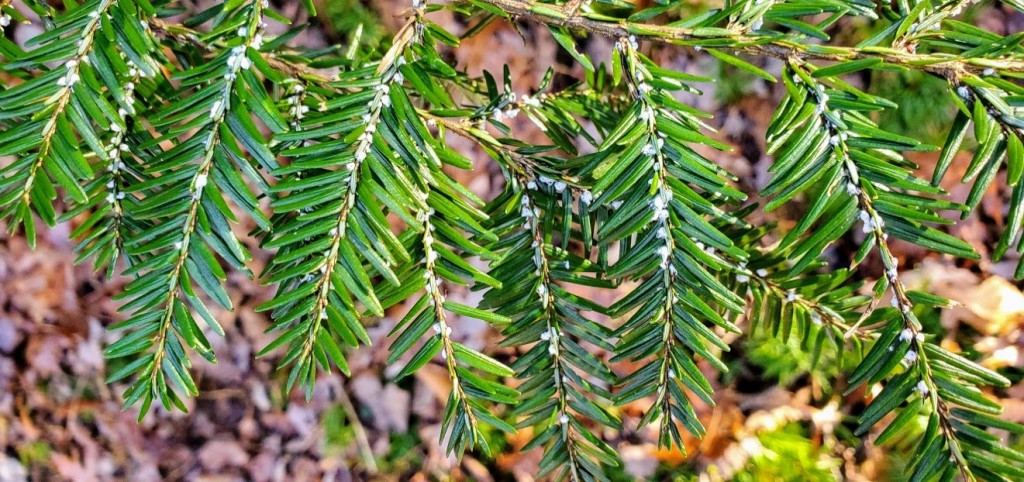Yesterday while walking with my faithful companions Susie Q and Maggie Mae, I was admiring the signs that spring has sprung. Cast an eye into the woods and you’ll see a horde of ferns pushing their way through the leaf litter, dogwoods decorate the wood line, gracing us with their delicate blooms, and songbirds are working tirelessly to build their spring nests. While many of our beautiful native plants are beginning to emerge, unfortunately we must take the good with the bad. In instance, the bad I saw on my walk was the Hemlock Wooly Adelgid (HWA), an invasive insect that has been ravaging Georgia hemlock tree communities since 2003.

Hemlock Wooly Adelgid feeding on underside of Eastern hemlock foliage.
As with most invasive species, native ecosystems lack the natural checks and balances that would otherwise help keep pest pressure in check. Thus, populations of HWA build quickly and can take out large, healthy trees in just a few years. By 2012, HWA had spread throughout the entire state’s hemlock range, leaving millions of trees dead and many others in severe decline.
This is a concern because the Eastern hemlocks (Tsuga Canadensis) and their close relative, Carolina hemlocks (Tsuga caroliniana), are “keystone species”, meaning they help define an entire ecosystem. Shade, temperature, moisture, stream flow rates, water quality, soil pH, and soil nutrients are affected by hemlock growing in the forest. The loss of shade in riparian areas leads to higher stream temperatures and a decrease in aquatic species diversity. Thus, the loss of hemlock is both ecologically and environmentally devastating, as if it is eliminated, there is no other native conifer that will fill hemlock’s role in the forest.
Since the HWA is such a tiny pest it would be very hard to spot if it were not for its habit of wrapping itself in woolly white fibers that look just like the tip of a cotton swab. These small white masses appear at the base of the hemlock needles neatly arranged down the twigs of the hemlock trees. This time of year the woolly masses are most clearly visible. If you were to tear open the woolly sac and look with a magnifying class you can see the female and lots of tiny eggs.
Although the HWA usually produces two generations a year they appear the most visible to a casual observer in the spring. The tiny crawlers that hatch are tough to see as are the resting nymphs that are in place in the fall. As the woolly sacs age they become dirty, torn, and weathers until they too are harder to see.
There are a couple of other disorders of the hemlock tree that folks can confuse with the HWA. Wax scales are tiny white round objects that appear on some hemlock twigs. Unlike the HWA, the wax scale does not appear woolly and fibrous; as the name implies it has a waxy surface. There is also a fungal disease of hemlocks, Rosellenia Needle Blight, which can attack hemlocks. This fungus turns the hemlock needles brown and often will cause them to clump together. In damp early morning hours you can even see some spider web-like fungal growth that is easily confused for HWA activity.
Now is the right time to check for HWA on your trees. If you find them then it is also the right time to begin control efforts. For homeowners, contact and systemic insecticides are the most practical methods available for treating HWA. Of these two, systemic insecticides are often the best choice for individual homeowners. Care should be taken when applying insecticides, including wearing personal protective equipment, being mindful of the site conditions and following label instructions.
Soil applications should NOT be made within 10 feet of a stream channel, lake, pond, or wetland. Do not use soil applications on rocky outcrops where there is very little soil around the base of the hemlock. Do not make soil applications immediately after rainfall or during a drought. The soil should be moist, not saturated, for maximum effectiveness.
To make HWA treatments easier for homeowners, UGA Extension, the Georgia Forestry Commission, and the UGA Warnell School of Forestry and Natural Resources partnered to create a soil drench kit that could be borrowed from participating Extension office. Both the Fannin and Gilmer County Extension offices have kits. If you’re interested in borrowing our drench kit, a refundable deposit of $50 is required at the time of pickup. The check will be returned when the complete kit is returned in good order. Please make sure all items are clean and dry before returning.
If you suspect that you have HWA you can send us a picture or bring in a large clipping from our tree, and I will be glad to examine it at the Extension office to confirm the presence of the pests. We’re also happy to assist you if you have more questions about chemical application or would like to borrow our soil drench kit to treat your trees.